As aptly pointed out by the Polish Nobel prize-winning poet Wisława Szymborska, humanity has adopted a number of aesthetic and moral resolutions with regard to nature.
And while those of a moral kind are slowly being retracted, the aesthetic ones prove a lot harder to eliminate. The comment was made in the context of caterpillars and butterflies, which seldom venture to the far north, but the Arctic is also home to animals commonly regarded as beautiful and those whose looks and manners do not generate much enthusiasm. Animals which are fat, bloated, pimpled and clumsy. In a word, walruses. But although their appearance is nothing short of astonishing, it is not why they merit a place in the Arctic Champions League.
The walrus (Odobenus rosmarus) is a carnivorous flippered marine mammal of the family Odobenidae. The term rosmarus was first officially used in 1539 by the Swedish scholar Olaus Magnus to tag a slightly exaggerated depiction of a walrus adorning his cartographic masterpiece, which is to say, a marine map of northern Europe. It is worth noting that Olaus Magnus, exiled from Sweden for unpopular religious beliefs, toiled at his map in Gdańsk, Poland, and it was to this city that he allegedly dedicated the final effect of his work. Two centuries later, another Swede, Carl Linnaeus, combined the term rosmarus with a Greek compound odobenus, creating what is to this day the official two-part name of the species. Translated into English, it means a tooth-walking sea horse, which is quite the name, isn’t it? It is almost a shame the animal is commonly referred to simply as a walrus.

Published in 1539, Carta Marina, or the marine map of northern Europe, was lavishly illustrated with images showing, among others, the animals inhabiting the area. One of them was, of course, the walrus. Olaus Magnus, Carta Marina (public domain)

When illustrating his masterpiece, Olaus Magnus filled the unavoidable knowledge gaps with figments of his imagination. As a result, in terms of ferocity, his walrus outshines even a nearby dragon. Olaus Magnus, Carta Marina – fragment (public domain)
A rich and relatively complete fossil record suggests very clearly that the family Odobenidae once boasted high species diversity. Only one of these species, however, has successfully stood the test of time. The walrus of today is, therefore, quite literally one of its kind. What also deserves a mention is a fact that the animal regarded as a symbol of the Arctic seems to have evolved from a tropical ancestor, whose gradual journey to the far north remains as yet shrouded in mystery. Nowadays, there’s no use searching for walruses outside the Arctic and even within its boundaries their distribution is discontinuous at best. This is because not all corners of the Arctic are to the animals’ liking. In some areas the water’s too deep, in others the bottom won’t do, while still elsewhere the beaches are overly steep or sea ice not plentiful enough. As a result, actual walrus habitats are scattered all over the place and even though all of them meet the exact same criteria, as environmental preferences of the walrus seem to have been implanted at the species level, from the point of view of genetics walruses are not, in fact, all the same.

Walruses are quite picky about their habitats. They have a particular liking for shallow, coastal waters with a sediment-rich bottom, just the right amount of sea ice and gently sloping beaches. © Christopher Michel (CC BY 2.0)
Today’s walruses are subdivided into two subspecies, which are geographically and reproductively isolated, meaning they do not interbreed or interact in any way. The Atlantic walrus (Odobenus rosmarus rosmarus) inhabits, as the name suggests, the northern parts of the Atlantic, from the north-eastern edge of Canada to the Russian archipelago of Novaya Zemlya. It is this subspecies that you can come across in Svalbard. The Pacific walrus (Odobenus rosmarus divergens) is found in the Bering Strait region, on the coast of Russia and Alaska. The two subspecies have more in common than not, but it takes only a glance to realize that in the Pacific walrus everything is bigger, from body mass and the length of tusks to the size of individual herds and the overall population. The most recent estimates, based mainly on satellite images, indicate that the population of the Pacific walrus is about 200 000 strong. The other subspecies is roughly 10 times less numerous, which is to a large extent due to man.
The most characteristic feature of the walrus is its impressive bulk. In Svalbard, adult males reach the length of up to 3.5 metres and weigh even 1.5 tonnes, which is over twice as much as the largest polar bear. And still the Atlantic walrus is the smaller of the two! The most important factor responsible for the animal’s size is fat (known as blubber), which keeps the walrus warm. And the fact that it spends much of its life in frigid water, where it loses heat 27 times faster than it does on land, calls for some truly heavy-duty insulation. Consequently, under a 4-centimetre layer of skin, a well-fed walrus hides a 10-centimetre-thick blubber suit, weighing even a few hundred kilograms. Out of concern for the animal’s thermal comfort, the evolution has rid its body of all unnecessary protrusions, which further diminished heat loss (by reducing the giant’s surface-to-volume ratio) and, as a bonus, made the walrus into a still better swimmer, giving it a more streamlined shape. What’s interesting, as a side effect of the evolutionary necessity to eliminate protrusions, smaller males can only be distinguished from larger females during the mating season, as outside of it the most obvious attributes of their masculinity are held out of sight inside their bodies. And they do have plenty to hold in there. A walrus baculum, or its penis bone, may be as long as 60 cm. Found in the animal kingdom are, of course, better endowed species, but in terms of the length of the baculum the walrus outmatches all competition.
And where does the walrus get the energy to power its enormous body? From the sea bottom, where it forages with impressive efficiency for benthic molluscs and crustaceans, which make up its staple diet. Because walruses stay in coastal areas, the sea bottom is never too far away and the animals generally dive no deeper than 80 m. It does not mean, however, that’s all they’re capable of. According to the information published by the Norwegian Polar Institute, the record depth reached by the walruses of Svalbard is 450 m and the maximum dive time measured to date is 37 minutes. Besides, it turns out that walruses may well hold the world’s record for continuously staying awake. Research reveals they may swim almost non-stop for over 80 hours. Other animals, including us humans, can also put up with no sleep for as long as that, but only walruses do so regularly and without much effort. Or reason. Because what usually keeps them awake is no more than a prospect of yet another bite to eat.
This brings us to another leaf in the walrus’s laurels, namely the legendary whiskers, which are as prominent in the males as they are in the ladies. Unlike the typical moustache, walrus whiskers, also known as vibrissae, are no decoration. They are supplied with blood and nerves, which makes them into hypersensitive organs of touch, roughly comparable to human fingers. Arranged on the animal’s snout in several neat rows and ranging from four to seven hundred, vibrissae supplement the sense of vision and make it easier for the walrus to take care of its business in the murky depths of the ocean. It is them that the animal uses to locate its buried prey, which it then stirs up with high-pressure jets of water squirted out of its nostrils and, if necessary, sucks out of the shell with its powerful vacuum mouth. Even though the walrus is known for its taste for clams, there’s not usually enough of them for the whole herd to feed on clams alone. Especially that during a single trip to its underwater dinner table, a walrus can consume as many as 6000 bottom-dwelling organisms! The unbridled appetite of the blubbery giant stems from the fact that its daily caloric demand is only met by a portion of meat equivalent to almost 6% of its body mass, which for an average male means a whopping 60 kg. As a result, the walrus will eat just about any bottom dweller it chances upon: clams, shrimp, snails, crabs, sea cucumbers, all sorts of marine creepy crawlies and the occasional rock. After such a meal, the whole herd invariably goes ashore for a siesta. And because walruses are seldom in a hurry, their siestas can easily last a week.
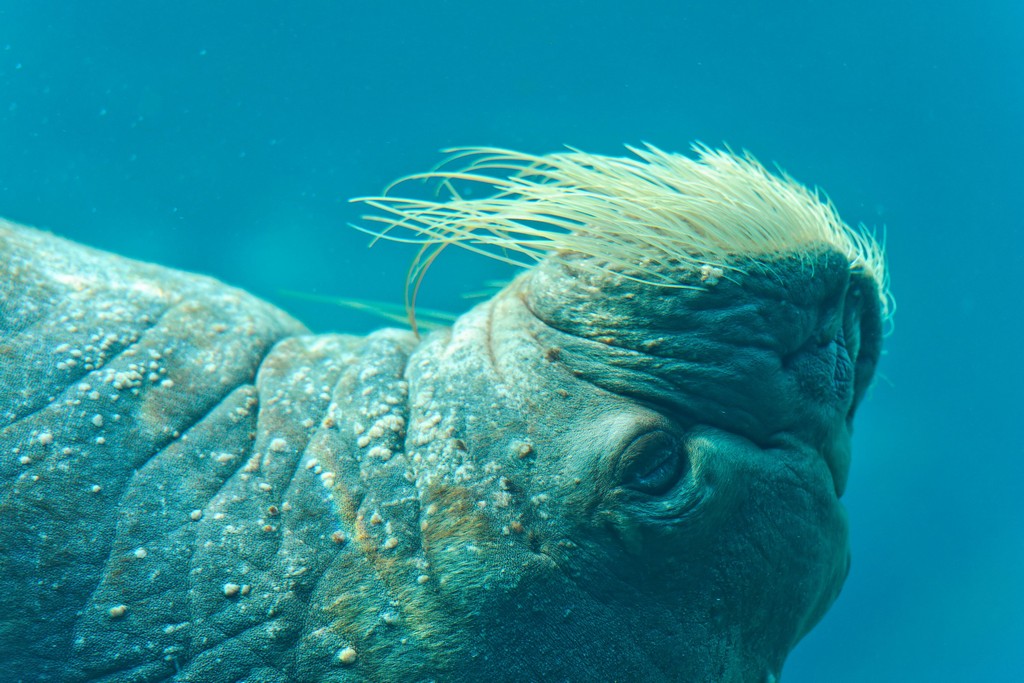
In theory, walrus whiskers can be as long as 30 cm, but they’re worn to much shorter lengths due to constant use. Really long whiskers are only typical of individuals that, like the one in the picture, live in captivity. © Tambako The Jaguar (CC BY-ND 2.0)
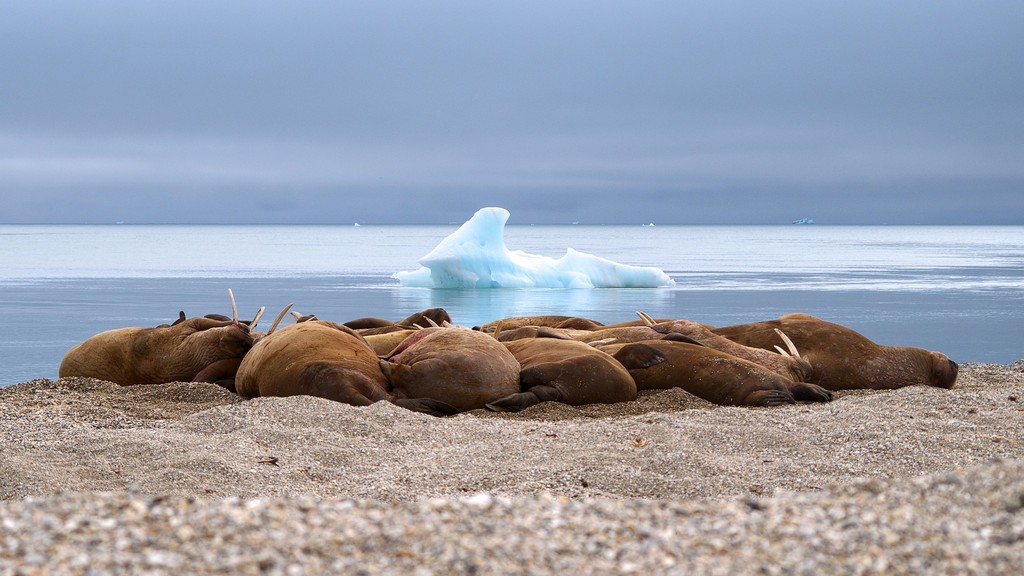
A herd of Atlantic walruses during a siesta. Such scenes are usually accompanied with sound and olfactory effects which make it quite clear that the walruses are busy digesting. © Rob Oo-offline (CC BY 2.0)
If vibrissae are the walrus’s standard tool, what foraging function is served by the animal’s tusks? It turns out that none, because toothless individuals are as large and well fed as their toothy friends. The walrus uses its tusks as ice axes to scramble out of the water onto the ice. They’re also a useful defence against predators. Most of all, however, they make it quite easy to establish social hierarchy within the herd, as the bigger the tusks, the more important you are. Tusks keep growing throughout their owner’s life, reaching – especially in males – even a metre in length. Provided they don’t get broken. Although walruses are seldom aggressive, they do get occasionally involved in minor scuffles, which in the mating season may develop into bloody battles. This is because it’s the largest and strongest males that enjoy a monopoly on reproduction, which the smaller and weaker ones are not too happy about. Emboldened by raging hormones, they regularly challenge the dominant males in single combat and they do have much to fight for, as the winner claims not just a single female, but the entire harem. Where there is much to gain, however, there’s also much to lose. Broken tusks are slow to grow back and sustained wounds may, in extreme cases, prove fatal.
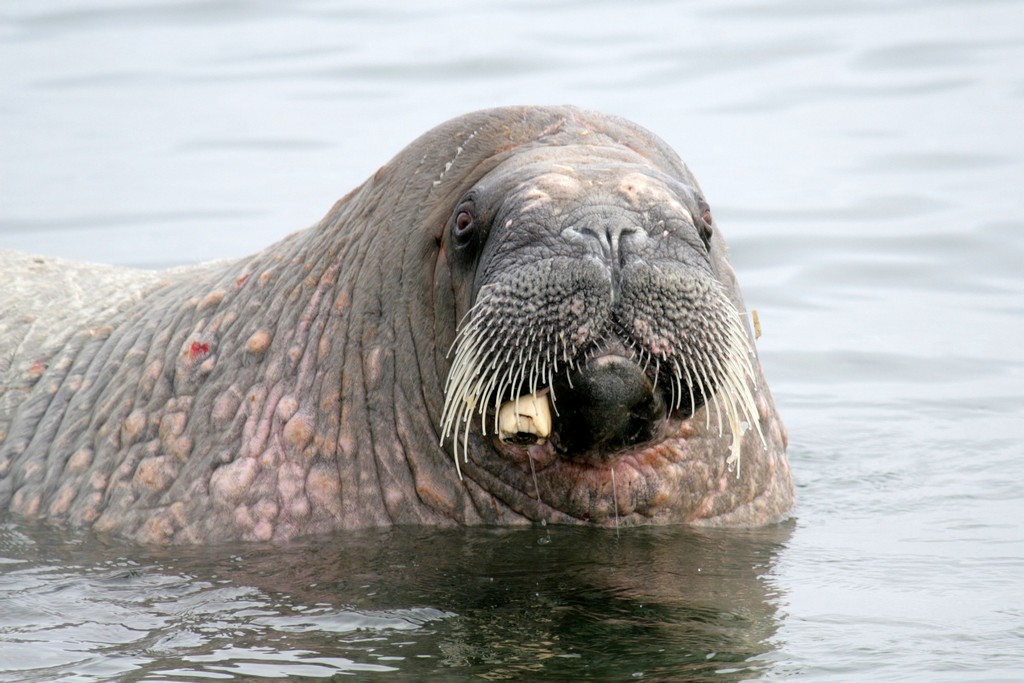
Broken tusks will ultimately grow back, but for now the toothless male has no chance with the ladies. © foilistpeter (CC BY-NC 2.0)
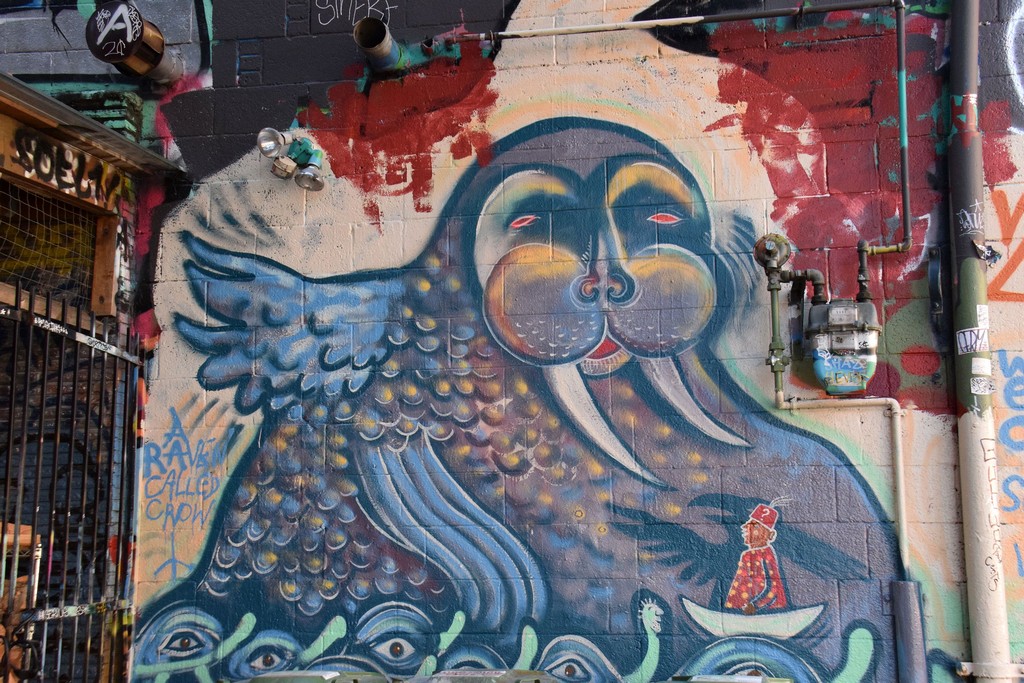
Even though walruses are seldom aggressive, coming this close to them is not the best of ideas, as they may damage a rubber boat or capsize a kayak. You should stay on your guard especially around males in the mating season and females with young. The picture shows a walrus adorning one of the walls in the capital of British Columbia, Canada. © Lotus Johnson (CC BY-NC 2.0)
Due to the impressive size of their bodies and tusks, walruses have few natural predators. In water, they’re regularly hunted only by killer whales and these the walrus should indeed avoid. On land, the biggest threat to the walrus is the polar bear, or rather the panic caused by its unexpected charge. This is because a frantic exodus of clumsy giants may well lead to injuries or even death of smaller individuals caught in the midst of an escaping herd. And that’s exactly the effect the attacking bear is believed to be aiming at. One-on-one battles are rare and are usually provoked out of bravado (or desperation), as for a polar bear a clash with a full-grown walrus may end tragically, especially if in the heat of things it follows its opponent into the water. As a result, with a bit of luck the walrus may live up to 40 years old, although there once was a time when very few managed to do so. Bad luck had it that the same features which kept the walrus relatively safe for many millennia, provided an impetus for slaughter that the Atlantic walrus barely survived.

A male Atlantic walrus at the headland of Poolepynten in Svalbard. Although walruses have few natural predators, someone usually keeps guard over a resting herd. © Gary Bembridge (CC BY 2.0)
The walrus long served a prominent role in the lives of indigenous Arctic peoples, because each individual provided a generous supply of valuable resources. Hardly anything got wasted. Walrus meat was an important ingredient of the Inuit’s daily diet. Flippers, considered a delicacy, were relished during special events. Tusks and bones provided material for tools and traditional handicrafts. Blubber, used as fuel for lamps, gave warmth and light. Thick hide was used for making ropes and boat covering, while intestines were fashioned into waterproof parkas. Walruses were, therefore, a prime target of subsistence hunting, but the numbers killed were small enough for the walrus population to thrive nonetheless. And in Svalbard, which lacked a native population, walrus hunting did not exist at all. Until in the 17th century Europeans set their foot on the islands.
The most destructive for the walrus was the encounter with the Pomors, who arrived in Svalbard from the coast of the White Sea. Familiarity with Arctic conditions, a range of clever hunting tricks and a complete lack of scruples meant they could deplete the local population of walruses by several hundred individuals in just a few hours! Their strategy was as simple as it was gruesome. They would stealthily approach a beached herd from the shore and kill the outermost individuals, so that their bodies blocked the escape route for the rest of the group. And because the herds of the time could number up to a thousand animals, the losses were enormous. For the walrus, that is, because for the hunters it meant nothing but profit. As was already mentioned, the walrus yielded a range of valuable resources, of which the most sought-after in Europe was walrus ivory, used as material for the production of luxury trinkets. Harder, whiter and more resistant to yellowing than elephant ivory, it fetched sky-high prices on European markets. It is hardly surprising, therefore, that walruses soon began to be hunted exclusively for their tusks. It is unclear how many of them fell prey to European greed, because nobody kept detailed records of the slaughter. What is clear, however, is that in 1952, when the Norwegian government finally put a complete ban on walrus hunting, the coast of Svalbard was still home to a mere hundred survivors.

Commercial hunters preyed on the animals’ gregariousness and their habit of going ashore at fixed locations. The image shows a herd of the Atlantic walrus on Northbrook Island in the Russian archipelago of Franz Josef Land. © Dunk (CC BY-SA 2.0)
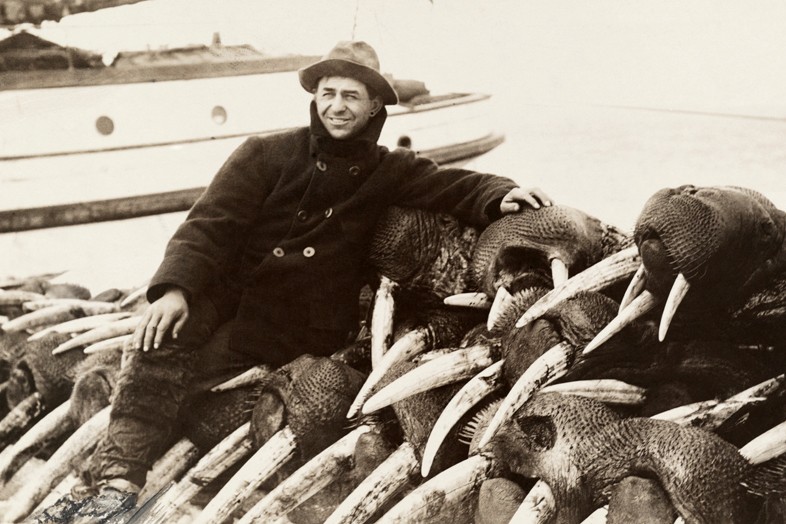
For the “civilized” world, the most precious part of the walrus was its tusks. As a result, commercial hunters took only the heads of slaughtered animals, leaving the bodies behind. The image shows Pacific walruses, but the strategy adopted when dealing with their Atlantic cousins was exactly the same. Beverly B. Dobbs, 1911 (public domain)
The fate of the walruses of Svalbard was hanging by a thread for the next two decades, because the animal holds a record in one more important field – it has the slowest reproduction rate of all modern pinnipeds. Females reach sexual maturity after about 6 years, but do not typically mate for another four. Males start even later, because although most of them are ready to rock at the age of seven, a strict hierarchy within the herd means they will be at least twice as old before they finally manage to dominate other males for mating privileges. The courtship starts at the end of winter and, even if everything goes as planned, a single baby walrus will not be born until the following spring. Afterwards, it will remain in the care of its fiercely protective mother for almost 3 years, which is – yep, you’ve guessed it – another record. Only after this much time is the young walrus ready to switch from milk to meat and face the daily challenges of polar life on its own. Even though at this point a sibling is usually on the way, a demographic explosion is a non-issue for the species and making a full recovery after centuries of human overexploitation is bound to take decades. Luckily, when left alone, walruses are doing fairly well and their numbers around Svalbard are steadily rising. According to systematically conducted surveys, in 2018 the walrus population the Norwegian archipelago shares with Russian Franz Josef Land comprised 5500 individuals, which meant an increase of over 40% within six years. And although the total number of Atlantic walruses is still a mere fraction of their original population, the return of this striking animal to its former home is no doubt a reason for optimism.
Text and English translation: Barbara Jóźwiak
Sources:
Hacquebord, L. (2001). Three centuries of whaling and walrus hunting in Svalbard and its impact on the Arctic ecosystem. Environment and History, vol. 7(2), pp. 169–185 https://doi.org/10.3197/096734001129342441
Horton, J. (?) How walruses work [blog post]. HowStuffWorks: Animals https://animals.howstuffworks.com/mammals/walrus.htm
Kubny, H. (2022-04-07) Hunting ban helped the walrus on Svalbard. Polar Journal: Science https://polarjournal.ch/en/2022/04/07/hunting-ban-helped-the-walrus-on-svalbard/
Murray, A., Bradshaw, P. (2016) Earth’s greatest spectacles, Episode 2: Svalbard [TV documentary] https://www.dailymotion.com/video/x4cvpq4
Norwegian Polar Institute (?) Wildlife in polar regions: Walrus (Odobenus rosmarus) [blog post] https://www.npolar.no/en/species/walrus/
Pryaslova, J. P., Lyamin, O. I., Siegel, J. M., Mukhametov, L. M. (2009). Behavioral sleep in the walrus. Behavioral Brain Research, vol. 201(1), pp. 80–87 https://doi.org/10.1016/j.bbr.2009.01.033
Storå, N. (1987) Russian walrus hunting in Spitsbergen. Études Inuit Studies, vol. 11(2), pp. 117–137 https://www.jstor.org/stable/42869607
Szymborska, W. (2015) Wszystkie lektury nadobowiązkowe. Wydawnictwo Znak, Kraków
Vlessides, M. (2000-11-01) In Search of the Tooth Walker [blog post]. The National Wildlife Federation https://www.nwf.org/Magazines/National-Wildlife/2000/In-Search-of-the-Tooth-Walker






